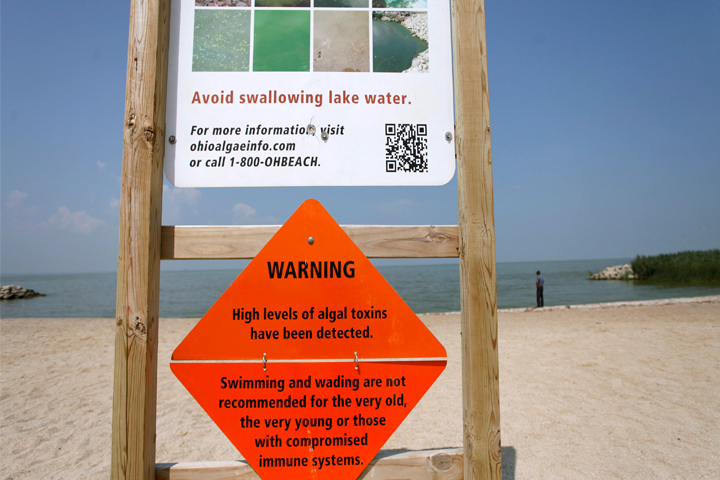
Trump Could Drain Great Lakes Cleanup Budget
Funding to protect drinking water for 35 million people may be cut 97 percent
By Jennifer Lu
InquireFirst
The future of the world’s largest fresh water source could be imperiled by a Trump administration proposal to cut federal funding for the restoration and protection of the Great Lakes from $300 million to just $10 million.
The Great Lakes provide drinking water to 35 million people across eight states and two Canadian provinces, including the cities of Chicago, Buffalo, Duluth, Toronto, Milwaukee and Cleveland. Tourism along the Great Lakes is a multi-billion dollar industry that supports more than 200,000 jobs.
The 97 percent cut to the Great Lakes Restoration Initiative, an inter-agency program led by the U.S. Environmental Protection Agency, was in a proposed budget obtained by media outlets earlier this month. The Great Lakes would also be impacted by steep reductions to the National Oceanic and Atmospheric Administration, or NOAA, and the U.S. Coast Guard.
David Spangler, a Lake Erie charter boat captain, accused the administration of “throwing Lake Erie under the bus.”
The administration’s final budget is expected to go to Congress on Thursday. The EPA said in an email that it is not commenting on proposed cuts.
The Great Lakes Initiative has supported almost 3,500 projects since 2010. The funds have been used to clean up toxic sites, control invasive species, preserve native species and track environmental pollution.
The money also supports research to address the increasing number of algal blooms in the Great Lakes. The blooms feed off nutrients from farm runoff and can cover several hundred square miles, consuming the water’s oxygen and leaving behind massive dead zones. Some species produce toxins that damage the liver and nervous system, sometimes fatally, if ingested.

In 2014, a toxic bloom over Lake Erie left 400,000 residents of Toledo and Lucas County, Ohio, without drinking water for three days. The county used money from the Great Lakes Initiative to slow farm runoff by restoring nearby wetlands. It also upgraded its water treatment plant to deal with future blooms.
Politicians think money from the Great Lakes Initiative is “loaded into a rocket and launched to the moon and we never see it again” when in fact, more than half of all the projects create cleanup and restoration jobs, said Ronald Hites, a chemist at Indiana University.
Hites runs the Integrated Atmospheric Deposition Network, which has been measuring the amount of air pollution entering the Great Lakes for 25 years. His 13-person lab receives about $1 million annually from the Great Lakes Initiative.
“If we get cut by 97 percent, we’re out of business,” Hites said. “There’s no way we can do anything but maintain the old data….The Great Lakes need to be continually protected. It would be a disaster if monitoring would be suddenly stopped.”
‘Where fish go to die’
The lakes’ health has vastly improved since the 1960s, when unregulated dumping turned them into public sewers. Nutrients from human sewage encouraged algal growth that turned the waters green and lumpy, while mercury from industrial waste made the fish inedible.
The region’s pollution finally captured the public’s attention when the Cuyahoga River, which flows into Lake Erie, caught fire in 1969. Late night comic Johnny Carson called the Great Lakes “the place fish go to die.” In the 1971 edition of the Dr. Seuss book, The Lorax, the Humming-Fish commiserated over their polluted pond in the line, “I hear things are just as bad up in Lake Erie.”
A year after the Cuyahoga burned, President Richard Nixon founded the EPA and NOAA. In 1972, he and Canadian Prime Minister Pierre Trudeau signed the Great Lakes Water Quality Agreement, a bi-national commitment to clean up and protect the lakes. That same year, the United States passed the Clean Water Act regulating pollutants discharged into water.

More than 40 years of scientific research, conservation and environmental regulations have brought the Great Lakes back to life. But without constant vigilance, enforcement and support from federal agencies, scientists say the lakes’ health could quickly relapse.
Algae blooms, which had declined after regulations reduced the amount of sewage entering the lakes, came back with a vengeance in the late 1990s, triggered by phosphorus from agricultural fertilizers.
In 2015, the largest bloom to date—300 square miles—covered a portion of Lake Erie the size of New York City, scoring a 10.5 out of 10 on the algal bloom severity index. Last year, Michigan designated its shoreline along the western basin of Lake Erie “impaired” because of persistent blooms.
Newer chemicals are also being detected in the water, such as flame retardants, pharmaceutical compounds and personal care products.
The Great Lakes Fish Monitoring and Surveillance Program, which receives a little more than $1 million a year from the Great Lakes Initiative, has been screening fish for mercury and other contaminants since the 1970s. Without that data, “we wouldn’t be able to make any decisions on the Great Lakes using science,” said Thomas M. Holsen, Clarkson University professor of civil and environmental engineering and a principal investigator of the Great Lakes Fish Monitoring and Surveillance Program.
Toledo residents share concerns
Tina Wozniak, a county commissioner in Lucas County, Ohio, is so concerned about Great Lakes funding that she organized a public forum in Toledo on March 9.
Until recently, Wozniak thought that algae and invasive species were the greatest threats Lake Erie faced. Now she fears that the enemy is a federal government trying to incapacitate the EPA. “We can’t afford to take steps backward,” she said.
David Spangler, the charter boat captain who complained the Trump administration is “basically throwing Lake Erie under the bus,” was among the 80 or so people who showed up for the meeting. He lost 20 percent of his business during the 2015 algal bloom, and he fears the same thing could happen again.
Spangler worries that the lakes will suffer from a proposed $1.3 billion cut to the U.S. Coast Guard. The Coast Guard inspects freight ships entering the Great Lakes to make sure invasive species—which could decimate the native fish that support Spangler’s charter boat business—aren’t stowed away on the hulls.
The Great Lakes would also be affected by the Trump administration’s proposed 17 percent cut to NOAA’s budget.
The Cooperative Institute of Limnology and Ecosystems Research at the University of Michigan depends on NOAA funding for one of its most important tasks: using genetic sequencing to determine whether algal blooms are toxic.
“We literally call Toledo to get out the charcoal filters and change the intake pipes if there’s the threat of a harmful algal bloom,” said the institute’s director, Bradley Cardinale. “If this program is stopped, cities like Toledo and Chicago are not going to get the information they need to protect their drinking water supply.”

All 28 researchers at the institute would lose their jobs if the funding were eliminated, Cardinale said. The jobs of 124 researchers shared by the university and NOAA would also be jeopardized.
Cardinale said he is angry that President Trump campaigned on the promise that he would bring back jobs to the Rust Belt, but now seems intent on slashing programs critical to the people living in the states that helped get him elected. Trump won five of the eight states that border the Great Lakes.
If the EPA is cut, Cardinale said, “we’re not going to have any of the protections that were put in place in the 70s, after Lake Erie caught on fire. The EPA exists because it protects public health. And we’re going to have a lot of public health problems if the EPA is not around.”
Correction: A sentence comparing the cost of President Trump’s trips to Mar-a-Lago, Fla., to his proposed budget for the Great Lakes Initiative has been removed from this story, because it used information that may not accurately reflect the cost of Trump’s trips. The sentence was based on a U.S. Government Accountability Office analysis of a four-day trip taken by President Obama in 2013 from Washington, D.C., to Chicago and Palm Beach. But presidential trips include so many variables that the GAO findings can’t automatically be applied to Trump’s visits.
Jennifer Lu is an InquireFirst intern. Her work is funded by a Larry J. Waller Investigative Reporting Fellowship from the University of Missouri and support from the Council for the Advancement of Science Writing through The Brinson Foundation.
